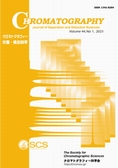Volume 44, Issue 1
Displaying 1-6 of 6 articles from this issue
- |<
- <
- 1
- >
- >|
Reviews
-
Article type: review-article
2023 Volume 44 Issue 1 Pages 1-9
Published: February 20, 2023
Released on J-STAGE: March 11, 2023
Advance online publication: February 09, 2023Download PDF (2047K) -
Article type: review-article
2023 Volume 44 Issue 1 Pages 11-19
Published: February 20, 2023
Released on J-STAGE: March 11, 2023
Advance online publication: February 13, 2023Download PDF (931K) -
Article type: review-article
2023 Volume 44 Issue 1 Pages 21-26
Published: February 20, 2023
Released on J-STAGE: March 11, 2023
Advance online publication: February 15, 2023Download PDF (1136K)
Original Papers
-
Article type: research-article
2023 Volume 44 Issue 1 Pages 27-32
Published: February 20, 2023
Released on J-STAGE: March 11, 2023
Advance online publication: December 05, 2022Download PDF (2208K)
Short communications
-
Article type: research-article
2023 Volume 44 Issue 1 Pages 33-37
Published: February 20, 2023
Released on J-STAGE: March 11, 2023
Advance online publication: February 07, 2023Download PDF (1203K) -
Article type: research-article
2023 Volume 44 Issue 1 Pages 39-43
Published: February 20, 2023
Released on J-STAGE: March 11, 2023
Advance online publication: February 16, 2023Download PDF (766K)
- |<
- <
- 1
- >
- >|
